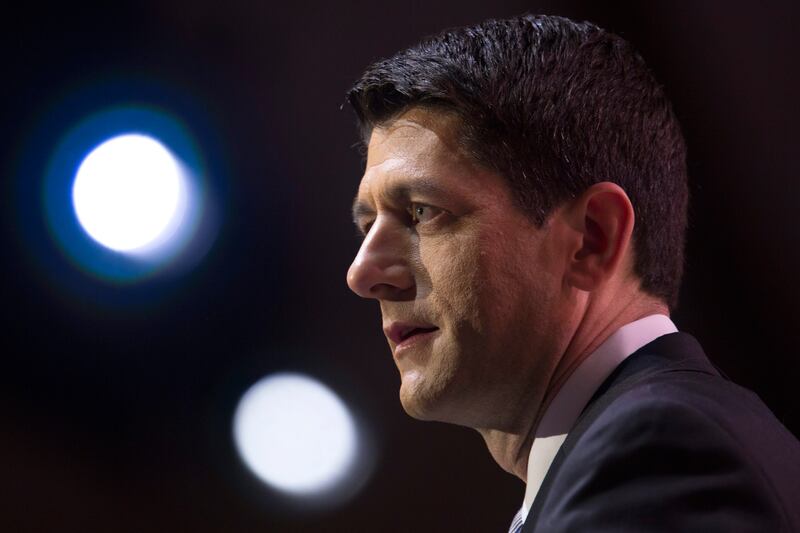Looking at Paul Ryan’s 2015 budget you might think that the Republican party base was simply a richer and younger America—and you’d be mistaken. But how else could you explain a budget that aims for balance by chivying the middle aged and the middle class, brands Medicare as “an open-ended, blank-check entitlement” (PDF)—as though Medicare was in the same league as league as welfare—and aims to cut Medicare spending by $129 billion?

From the vantage of demographics and exit polls, Ryan’s budget pokes a stick at the eye of the GOP’s older, working and middle class base. To be sure, Ryan offers Americans under 55 years old a subsidy to buy private health insurance and the “choice” of Medicare. But, Ryan commits the cardinal political sin of not offering the voters anything in return for stomaching his proposed cuts.
Yes, budgets may be statements of priorities, but in and of themselves they are not statements of persuasion. If a leader puts forth a vision of where the country needs to go, and the voters accept that vision, then the budget details will fall into place. The numbers will ride, as it were, on the coattails of the vision. But if the leader fails to gain acceptance, then the budget details are nothing more than wonk-trivia.
ADVERTISEMENT
Seen in this light, Ryan doesn’t seem to be trying anymore. His proposals are focused on numbers and orthodoxies alone, while ignoring reality and the larger picture. It may be hard to believe, but less than two years ago Mitt Romney invited Ryan to join him on a national ticket. Then again, we know how that experiment turned out.
Still, some believe that Ryan might like to be elected President someday, but at the rate he’s going, Ryan will be lucky to appointed to be Director of the Office of Management and Budget—and not a very popular OMB head at that.
Politically, Ryan’s budget utterly rejects the notion that Republicans must play Santa Claus if the GOP is to recapture the White House, and that’s bad politics and policy. To illustrate, in 2012 Romney-Ryan won a majority of voters aged 40 and up. But, it is this very demographic that stands to be hit by Ryan’s Medicare cuts, and by the costs and woes of diseases such as Alzheimer’s.
The Wisconsin congressman seemingly forgets that elections are transactional; that voters expect something in return—much as politicians themselves expect campaign donations. (Republicans, can you say Sheldon Adelson and the Kochs? Democrats, can you say George Soros and Tom Steyer?) Yet, Ryan wrongly views politics as a one-way street in which the electorate is the ultimate chump, and the average American is a mute mug.
Like it or not, the Republicans need to look beyond the apex of the economic pyramid, and offer something tangible to woo working Americans. So, for the GOP, it’s time to start focusing on 2016 and regaining the White House. And it’s not as though there isn’t enough material out there for the Republicans to work with.
For starters, job growth has been decoupled from workforce participation. While the number of Americans working in the private sector has returned to its pre-Great Recession level, the labor force participation rate has fallen to just over 63 percent, back where it stood when Jimmy Carter was president. Meanwhile, Floyd Norris of the New York Times reports that “total compensation of employees slipped to a 65-year low” on Obama’s watch.
So if Ryan weren’t suffering from a green eye-shade syndrome, he might also want to focus on Alzheimer’s. These days, Alzheimer’s is shaping up to be a major epidemic, and is the sixth leading cause of death in the U.S. Alzheimer’s not only threatens lives, but it also endangers growth, and even budgets.
Against this backdrop, Jim Pinkerton, a former White House domestic policy aide to Presidents Reagan and Bush 41, calls for a “Cure Strategy.” That is, do to Alzheimer’s what we did to polio—make it go away.
Yes, a science-based qualitative approach to healthcare policy (cure the disease) makes a lot more sense than the rote quantitative approach (assume no change in the science and simply cut the costs). But unfortunately, Ryan is a number-cruncher to his core. Looking ahead, in 2015 he will rise to the Chairmanship of the House Ways and Means Committee.
So, on some days anyway, it looks like Obama “gets it” in a way that Ryan and the Republicans do not. Sure, Obama connects with younger voters, and Ryan and the rest of the GOP never will. But it’s not just about Obama going on “Between Two Ferns” and yucking it up about Obamcare with Zach Galifianakis. No, it’s about not repeating unforced errors.
In case anyone forgot, last year Obama’s budget called for using a “chained CPI” for indexing Social Security benefits. Chained CPI is a more conservative way of measuring inflation and, in effect, an assault on already-retired seniors. After facing opposition from seniors and pushback from Senate Democrats, the proposal went nowhere and this year it was dropped from the president’s budget.
Unfortunately for the GOP, Ryan laments the demise of chained CPI, and takes the president to task for abandoning the “one signifiant reform he’s embraced.” At this rate, Ryan may hold the Ways and Means Committee gavel just long enough to get box seats to Hillary Clinton’s January 20, 2017 inaugural.






